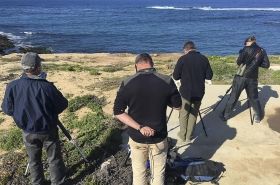In the future of wildlife tracking, sea otters have their own social network.
Whereas we might carry cell phones or tablets, each sea otter has a small, solar-powered tag clipped carefully to one of its flippers. When the sea otters gather to nap at the ocean’s surface, their tags boot up, and check in with one another. Who else did the sea otter interact with today, where, and when?
In the future of wildlife tracking, sea otters have their own social network.
Whereas we might carry cell phones or tablets, each sea otter has a small, solar-powered tag clipped carefully to one of its flippers. When the sea otters gather to nap at the ocean’s surface, their tags boot up, and check in with one another. Who else did the sea otter interact with today, where, and when?
For Joseph Tomoleoni of the U.S. Geological Survey and Zachary Randell of Oregon State University, this future would refine our understanding of sea otters’ community structure, movements, distributions, survival rates, and even disease transmission among individuals. Currently, USGS biologists like Tomoleoni and Brian Hatfield use radio transmitters, binoculars, and high-powered spotting scopes to track sea otters from shore. For hours at a time, they painstakingly record the otters’ location and behaviors off the California coast.
Yet, this lengthy, labor-intensive process happens only when the weather cooperates; if a storm rolls through, or if conditions along the coast are otherwise unfavorable, the scientists can’t collect their data. Because Tomoleoni, Randell, and Hatfield can only survey sea otters from the beach during daylight hours with reasonable weather, they get a part rather than the whole picture of sea otter ecology.
Continue reading at USGS.
Image via USGS.




